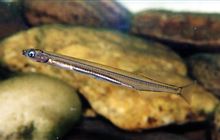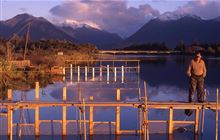Changes proposed to whitebait management in New Zealand
Introduction
Learn more about the proposals we sought feedback in 2020 to improve how we manage whitebait in New Zealand. Submissions closed 16 March 2020.Submissions closed 9 am, 16 March 2020
In 2018 DOC began a review of whitebait management in New Zealand. We gathered public feedback and used this to inform proposed changes to whitebait management.
In 2020, we proposed to help restore whitebait populations by:
- defining a goal and outcomes for whitebait management,
- amending whitebait fishing regulations, and
- phasing out of international export of whitebait.
To see full details for each of the below, see the Improving whitebait management (PDF, 7,631K) discussion document. Submissions closed 16 March 2020.
Goal and outcomes for whitebait management
Feedback during our public consultation in 2018 showed we needed a clear goal for whitebait management. In 2020, we proposed the following goal:
Ensure healthy and restored whitebait populations and provide for a sustainable fishery.
The proposed outcomes outlined in the discussion document was to guide our management of whitebait fishing. We aimed to create a nationally consistent approach to help safeguard whitebait.
Proposals to amend fishing regulations
The changes proposed in 2020 to the whitebait fishing regulations were to change current practices. These included:
- changes to fishing gear and practices,
- dates changes for the season,
- a limit to upstream fishing, and
- not allowing fishing in some areas to create whitebait refuges during set time periods .
Changes to fishing gear and practices
Changes are proposed to fishing gear and practices to reduce pressure on whitebait. The proposed changes in 2020 included:
- Phase out sock nets and traps in nets.
- Phase out screens (and prohibit diversions) or implement nationwide size and location restrictions for screens and diversions.
- Prohibit fishing for whitebait from structures other than stands and within 20 m of weirs, groynes and illegal diversions.
- Prohibit use of more than one net when fishing from a whitebait stand, which must not be located beyond the outer edge.
- Implement a maximum overall length limit of 6 m for fishing gear used to take whitebait (excluding spotter boards) nationwide.
- Revise regulations that provide for fishing gear to span up to one third of the width of a waterway. Set a specified minimum distance of 20 m between these fixed fishing gears (not stands).
Season dates
Three options were proposed to align the whitebait fishing season around New Zealand (excluding the Chatham Islands):
- 15 August – 14 October (DOC’s recommended option)
- 1 September – 30 October
- 1 September – 15 November (the current West Coast whitebait fishing season)
Upstream fishing limits
Two ways to introduce national upstream limits on whitebait fishing are proposed:
- limit the extent of whitebait fishing on selected rivers by introducing back-pegs that mark 'no fishing' areas
- where back-pegs are not in place, whitebait fishing only occurs within tidal portions of waterways.
DOC’s recommended option is to incorporate both approaches.
Whitebait refuges
Refuges were proposed for some rivers for whitebait species, where whitebait fishing is excluded. Three time periods for refuges are proposed, where whitebait fishing would be either:
- permitted for 2 years, then not permitted for the next 2 years in a repeating cycle
- not permitted for 5 – 10 years initially and then reviewed
- not permitted for at least 10 years then continued if no review is undertaken.
Possible refuge sites
We listed maps of the waterways with rivers across New Zealand which may provide potential refuges below.
DOC did not propose to create refuges at all of these sites. We sought more information during the 2020 consultation. To find out how we selected them, see the discussion document, pages 41 - 43.
Waterways are set out by name and region in the discussion document appendices (pages 80 – 123).
The yellow to brown shading on each map shows how much land around a river is protected. For example, a river may have a forest or wetland reserve next to it.
Protected land is important because the future of whitebait is expected to be more secure in areas where the land next to it is protected.
North island
- Northland (PDF, 514K)
- Auckland:
- Waikato
- Bay of Plenty (PDF, 545K)
- Gisborne (PDF, 472K)
- Taranaki (PDF, 588K)
- Hawke's Bay (PDF, 595K)
- Manawatu/Whanganui (PDF, 684K)
- Wellington (PDF, 497K)
South island
- Nelson (PDF, 401K)
- Tasman:
- Marlborough:
- Canterbury (PDF, 642K)
- West Coast
- Otago (PDF, 685K)
- Southland (PDF, 620K)
Phasing out international export
Phasing out the international export of the whitebait species was also proposed. This would not impact the sale of whitebait within New Zealand.


